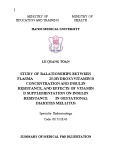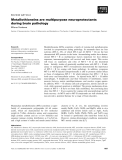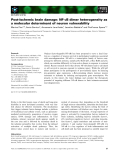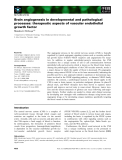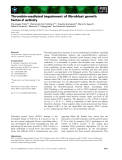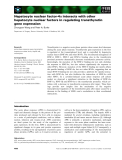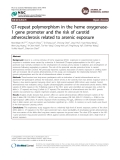
Pathological factors
-
Objectives: Identifying the species, distribution, biological characteristics and influential factors to the liver flukes infection rate in cattle the Mekong Delta. Suggesting the treatment methods for infected cattle in Mekong Delta.
 25p
25p  cotithanh321
cotithanh321
 06-08-2019
06-08-2019
 46
46
 4
4
 Download
Download
-
The objective of the research is: To determine the prevalence of vitamin D insufficiency in pregnant women at the National Hospital of Gynecology & Obstetrics and the National Hospital of Endocrinology; to explore relationships between plasma 25 hydroxy vitamin D concentration in women with gestational diabetes mellitus.
 29p
29p  change04
change04
 08-06-2016
08-06-2016
 30
30
 4
4
 Download
Download
-
Metallothioneins (MTs) constitute a family of cysteine-rich metalloproteins involved in cytoprotection during pathology. In mammals there are four isoforms (MT-I )IV), of which MT-I and -II (MT-I + II) are the best characterized MT proteins in the brain. Accumulating studies have demon-strated MT-I + II as multipurpose factors important for host defense responses, immunoregulation, cell survival and brain repair.
 14p
14p  inspiron33
inspiron33
 26-03-2013
26-03-2013
 33
33
 5
5
 Download
Download
-
Amyloid-b(Ab) aggregation and amyloid formation are key pathological features of Alzheimer’s disease, and are considered to be two of the major contributing factors to neurodegeneration and dementia. Identification of small molecule inhibitors that are orally available, have low toxicity and high central nervous system bioavailability is one approach to the potential development of a disease-modifying treatment for Alzheimer’s disease.
 12p
12p  media19
media19
 06-03-2013
06-03-2013
 50
50
 2
2
 Download
Download
-
Vascular endothelial growth factor (VEGF) family members play impor-tant roles in embryonic development and angiogenesis during wound healing and in pathological conditions such as tumor formation. Parapox-viruses express a new member of the VEGF family which is a functional mitogen that specifically activates VEGF receptor (VEGFR)-2 but not VEGFR-1.
 11p
11p  media19
media19
 05-03-2013
05-03-2013
 30
30
 3
3
 Download
Download
-
Nuclear factor-kappaB (NF-jB) has been proposed to serve a dual func-tion as a regulator of neuron survival in pathological conditions associated with neurodegeneration. NF-jB is a transcription family of factors com-prising five different proteins, namely p50, RelA⁄p65, c-Rel, RelB and p52, which can combine differently to form active dimers in response to external stimuli.
 9p
9p  vinaphone15
vinaphone15
 27-02-2013
27-02-2013
 29
29
 3
3
 Download
Download
-
The angiogenic process in the central nervous system (CNS) is basically regulated by typical angiogenic signaling systems such as vascular endothe-lial growth factor (VEGF)–VEGF receptors and angiopoietin–Tie recep-tors. In addition to regular endothelial–pericyte interaction, the CNS vasculature has a unique system of cell to cell communication between endothelial cells and astrocytes which is known as the blood–brain barrier.
 8p
8p  vinaphone15
vinaphone15
 25-02-2013
25-02-2013
 37
37
 3
3
 Download
Download
-
Thrombin generation increases in several pathological conditions, including cancer, thromboembolism, diabetes and myeloproliferative syndromes. During tumor development, thrombin levels increase along with several other molecules, including cytokines and angiogenic factors. Under such conditions, it is reasonable to predict that thrombin may recognize new low-affinity substrates that usually are not recognized under low-expression levels conditions.
 13p
13p  viettel02
viettel02
 22-02-2013
22-02-2013
 37
37
 3
3
 Download
Download
-
Accumulation ofb-amyloid protein (Ab) is one of the most important pathological features of Alzheimer’s disease. Although Abinduces neurode-generation in the cortex and hippocampus through several molecular mech-anisms, few studies have evaluated the modulation of transcription factors during Ab-induced neurotoxicity.
 10p
10p  viettel02
viettel02
 19-02-2013
19-02-2013
 38
38
 3
3
 Download
Download
-
Arsenic is a strong stimulus of heme oxygenase (HO)-1 expression in experimental studies in response to oxidative stress caused by a stimulus. A functional GT-repeat polymorphism in the HO-1 gene promoter was inversely correlated to the development of coronary artery disease in diabetics and development of restenosis following angioplasty in patients. The role of this potential vascular protective factor in carotid atherosclerosis remains unclear. We previously reported a graded association of arsenic...
 11p
11p  toshiba23
toshiba23
 18-11-2011
18-11-2011
 91
91
 3
3
 Download
Download
CHỦ ĐỀ BẠN MUỐN TÌM










